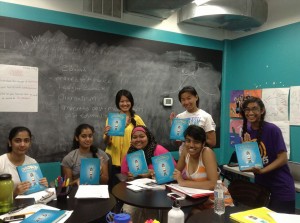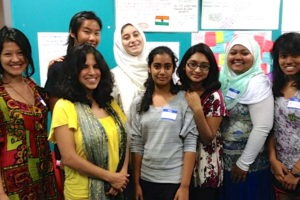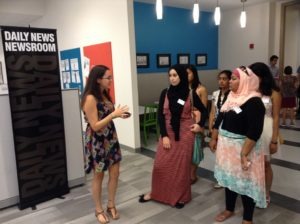Editor’s Note: In June, we introduced readers to SWYC, a writing workshop for high-school aged girls based in Philadelphia’s Asian Arts Initative, where participants gathered to learn and write about the South Asian diaspora. Below, learn more about the seven-week workshop directly from the participants themselves.

“What We Learned At SYWC” by Saranjeet Kaur and Afsara Ahona
At SYWC, we learned about a different theme each week. We started by scrutinizing labels and stereotypes of South Asians. We never realized the integral role it played in our society’s media until we watched Chimamanda Adichie’s video about a single story and the impact it can have.
Each week’s theme built upon the previous one. For example, we could relate “labels and stereotypes” to the theme of “Socially just media.” Socially just media does not mean having every race in every advertisement, but to show all sides to a story. When we see people like us on television, they are portrayed as doctors, engineers, or nerds. This was a topic that would never come up in a conversation with our friends because it was too sensitive.
One of the most illuminating themes was “South Asian history.” Learning about the forced diaspora of South Asian indentured servants to Fiji and assimilation to Fijian culture surprised and upset us. The history of South Asian migration is not usually included in the high school history curriculum and it was exciting for us to learn the stories of people who look like us.
We also talked about other themes like gender, religion, music, dance and social practices. We learned new vocabulary, new concepts and perspectives with which to think about our lives.
“Activities at SYWC” by Kimberly Gian and Yasmine Ayad
We used many activities to help us in our writing. The SYWC blog recorded most of the writing we produced. Having our writing published made us feel more professional about our work since it was exposed to a wider audience. Group discussions were always fun. For example, we split up into two groups to debate about social practices like arranged marriages and menstruation rituals, which really brought high excitement and energy into the room. It was amazing to know others’ thoughts and share our own.
Our favorite activity was when we had to write a speech about Malala Yousafzai and present it to the class. It was the best of all projects because we were able to put our public speaking to test and it challenged our ability to inform and persuade.
We were able to really improve our writing by exploring different styles and learning new ways to express ourselves aside from the average essay we would do in an everyday classroom.
“Speakers and Guests at SYWC” by Aishika Jennela and Jyot Singh

We had the privilege of meeting some incredible speakers who introduced us to challenging topics. Our first guest speaker Samip Mallick, the founder of SAADA, helped open our eyes to the fact that there were South Asians present in the American community as far back as the late 1800s, like Anandibai Joshee, a woman who came to study at the Women’s Medical College in Philadelphia in 1894. It was interesting to learn that South Asians have been in this country for so long, because they are typically absent in American history textbooks and movies.
Dr. Raili Roy, the Assistant Director of the South Asia Center in the University of Pennsylvania, came to talk to us about gender roles and stereotypes of South Asian women, while Kishwer Barrica from The Aerogram spoke about the media’s portrayal of South Asians. Both talks challenged me to think critically by having in-depth conversations about how South Asians are perceived.
Lastly, we had authors Rajdeep Paulus and Bushra Rehman come in to talk to us about autobiographical writing and the life of an author, which was helpful for me because I want to be a writer when I grow up.
“Field Trips By SYWC” by Rajia Mim and Devisha Walia

We were very fortunate to participate in various field trips. First, we visited the Summer Teachers’ Institute “No Longer the Other” at UPenn to listen to Ananya Dasgupta speak about women in Islam. Dasgupta’s discussion about the history of the veil in Algeria and references to powerful South Asian women like Razia Sultana and Benazir Bhutto taught me how to reverse society’s misconception that Muslim women are oppressed.
On the fifth week, we visited the Philadelphia History Museum where we learned about the representation of minorities in Philadelphia’s history. I noticed representation of multiple minorities throughout the museum: exhibits related to slavery, the Irish community, and the LGBTI community. I related this back to our class discussions on “socially just representation,” which means representing stories from different peoples in a just and socially-conscious way.
In the final week of our program, we traveled to Philadelphia Daily News’ office to explore journalism as a career. We took a tour of Philadelphia Daily News’ office, and talked to journalists Molly Eichel, Stephanie Farr, and 2010 Pulitzer Prize winner Wendy Ruderman about their careers and received advice on journalistic writing. These trips were informative, fun, and helped us connect with professionals in Philadelphia.
Please connect with SYWC founders Afsana Oreen and Sabrina Singh on Facebook, or write to them at sywc13@gmail.com. You can also read and submit your writings to their blog.












